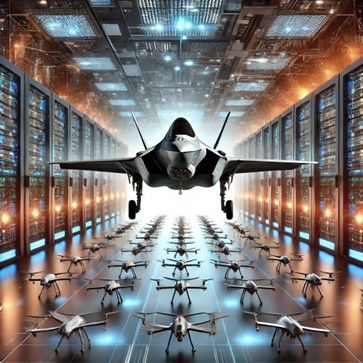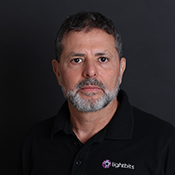
Elon Musk’s recent tweet sparked an interesting debate about the future of warfare and AI’s role in shaping it. While the F-35 is a state-of-the-art war machine, Musk argues that it’s an overcomplicated “appliance” with a “single point of failure” — basically a relic of the past— whereas a swarm of 10,000 autonomous drones offers adaptability, resilience, and no single point of failure. Sound familiar?
Software-defined infrastructure is everywhere these days. What role will software-defined storage play in the future datacenter?
The Datacenter Parallel: Commodity Hardware vs. Monolithic Appliances
From a technology perspective, modern data centers are already moving toward a similar model. Over 40% of the world’s data and compute workloads are hosted in “public clouds” (AWS, Azure, GCP, Alibaba, Meta, Oracle). These hyperscalers prioritize cost, flexibility, and agility — leveraging commodity hardware with distributed orchestration layer to manage failures at the software layer. Instead of relying on a single high-end “supercomputer,” cloud providers deploy hundreds of thousands of servers that can be dynamically repurposed based on real-time applications/customer demand.
AI and the Economics of Scale
In the race for AI and compute dominance, the key differentiator is access to scale at the lowest possible cost. Did anyone mention DeepSeek? Achieving such “hyperscale” is not realized through massive, singular supercomputers or appliances but rather through optimized, distributed software architectures running on the latest commodity hardware. This shift underscores the need for cloud infrastructure that is software-driven, scalable, and cost-efficient.
Why Tier-2 Cloud Service Providers Must Transition to Software-Defined Storage
Tier-2 Cloud Service Providers (CSPs) are at a crossroads. As AI workloads and cloud-native applications grow exponentially, CSPs must deliver high-performance, scalable, and cost-efficient infrastructure while keeping power consumption and operational overhead low. The answer? Software-defined everything and, more specifically, Software Defined Storage (SDS).
The Economics of Cloud Infrastructure Are Shifting
Traditional storage architectures, reliant on proprietary hardware and legacy networking protocols, no longer align with the economics of modern cloud infrastructure. Unlike large enterprises that invest in custom appliances, CSPs operate with a different philosophy: they buy white-label servers and use software-defined architectures for agility and cost control. Investing in expensive, monolithic storage appliances contradicts this model—creating vendor lock-in, increasing management complexity, and reducing agility.
Scalability and Hardware Repurposing Are No Longer Optional
Tier-2 CSPs must adapt to changing workloads in real-time—whether it’s a massive AI training dataset, inference clusters, or high-speed databases. Legacy storage solutions lack the flexibility to reallocate resources dynamically, leading to inefficiencies and inflated costs. SDS allows CSPs to programmatically manage and optimize storage, ensuring hardware remains fully utilized and relevant as workloads evolve.
The VMware Paradigm Shift: CSPs Need a New Strategy
For years, VMware was the go-to platform for many CSPs. I even recall VMware marketing itself claiming “… we are the 4th largest distributed cloud provider ….” That might have been true three years ago, but the paradigm has changed. With Broadcom’s recent licensing changes and the growing dominance of AI workloads, CSPs must seek cost-effective, flexible alternatives. Open-source, Kubernetes-based environments are rapidly replacing traditional hypervisors like VMware and Nutanix, demanding a storage solution that aligns with cloud-native principles—where SDS with NVMe® over TCP storage stack excels.
Standardized, Simple, and Scalable Networking
One of SDS’s biggest advantages—especially with NVMe/TCP—is its ability to leverage existing TCP/IP networks without requiring specialized hardware. Unlike Fibre Channel appliances or proprietary RDMA-based solutions, NVMe/TCP seamlessly integrates into cloud environments, reducing switching & routing complexity as well as operational overhead while eliminating vendor lock-in.
Performance, Density, and Power Efficiency Define Profitability
Tier-2 CSPs derive profit by maximizing the number of virtual machines (VMs) and containers per physical server. To compete with Tier-1 hyperscalers, they must achieve high compute density while minimizing power consumption. Proprietary appliances are no longer an option—SDS running on the latest hardware (e.g., 5th Gen AMD EPYC processors) delivers the highest IOPS and lowest consistent latency, enabling more VMs/pods to run with fewer physical resources. This directly reduces the total cost of ownership (TCO) and makes their cloud offerings more competitive.
Scale with F-35 or 10,000 Drones?
For Tier-2 “Cloud Builders,” the answer is clear: competing with Tier-1 cloud providers using expensive, proprietary “appliances” storage is unsustainable. The cloud computing landscape is evolving, and CSPs that fail to modernize risk becoming both expensive and irrelevant. SDS with NVMe/TCP offers a compelling solution that is cost-efficient, flexible, and scalable. By making this transition now, CSPs can future-proof their infrastructure, optimize costs, and deliver the high-performance cloud services their customers demand.
The time to transition is today!
Lightbits is a software-defined storage solution designed for high performance, scale, efficiency, and flexibility. Lightbits is architected from the ground up to deliver the speed and efficiency of direct-attached SSDs with the flexibility and manageability of networked storage. We’re the inventors of NVMe over TCP, a protocol that allows you to get near-local NVMe performance over standard TCP/IP networks. This means you can have your cake and eat it too – enjoy the performance of local SSDs with the scalability and ease of management of networked storage, all without specialized networking hardware.

